Work Flexibility and Incentives: A Business Analysis
VerifiedAdded on 2023/06/05
|15
|3915
|344
AI Summary
The report discusses the concepts of work flexibility and incentives in the specific light of the fictional organizational Thrive consultancy. It includes a literature review on the topics of work flexibility and Job demand Resources theory (JD-R) and also analyzes the manner in which these two concepts can help the organization to resolve the issues it is facing at the current moment. Furthermore, the report takes into effective consideration the results of an interview which was conducted on five people to analyze the manner in which the changes implemented by the organization have affected them. Finally, the report concludes with two recommendations, namely, the use of work flexibility and incentives and also the effective use of Job demand Resources theory (JD-R) for the resolution of the issues that the organization Thrive consultancy is facing at the current moment.
Contribute Materials
Your contribution can guide someone’s learning journey. Share your
documents today.
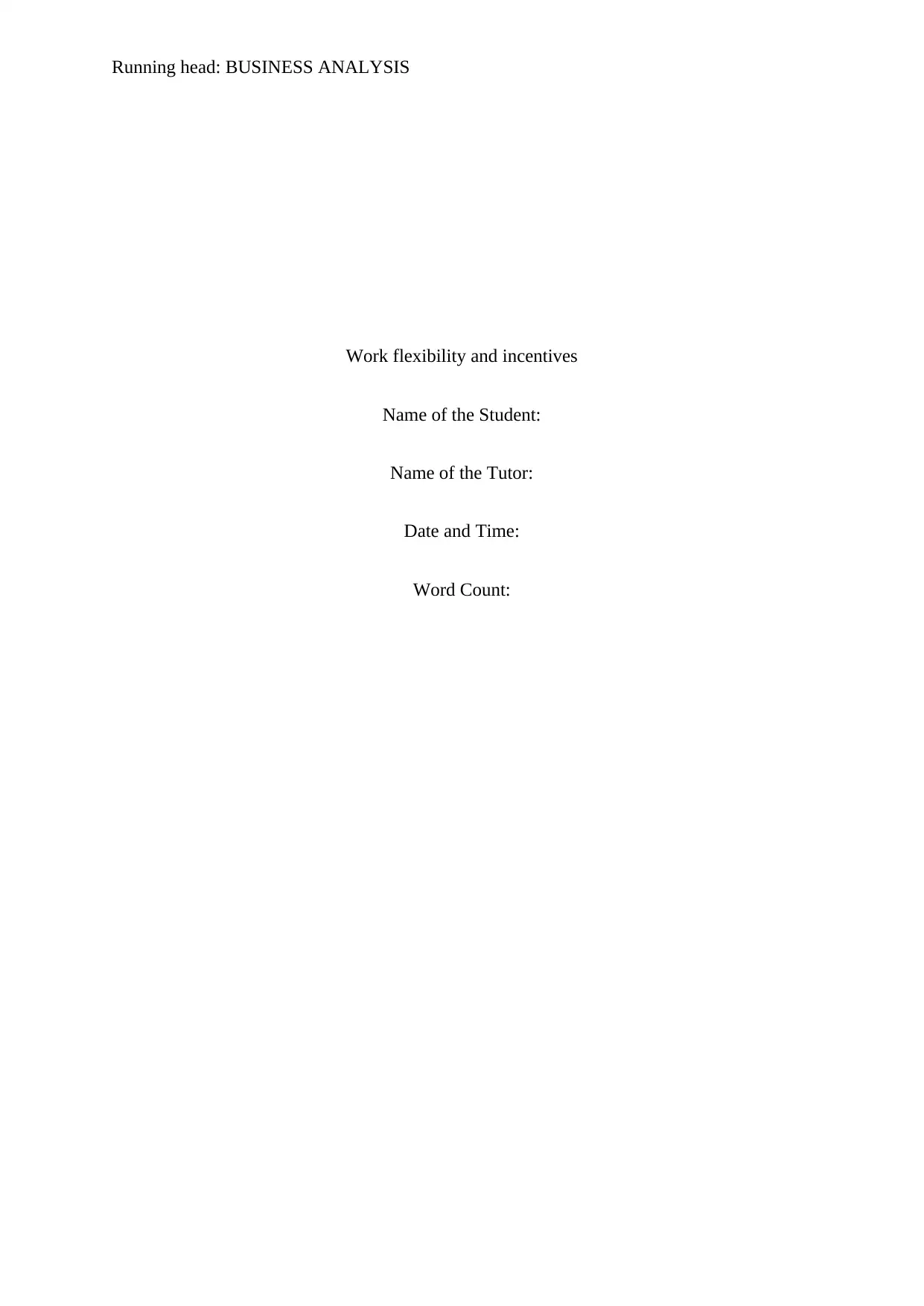
Running head: BUSINESS ANALYSIS
Work flexibility and incentives
Name of the Student:
Name of the Tutor:
Date and Time:
Word Count:
Work flexibility and incentives
Name of the Student:
Name of the Tutor:
Date and Time:
Word Count:
Secure Best Marks with AI Grader
Need help grading? Try our AI Grader for instant feedback on your assignments.
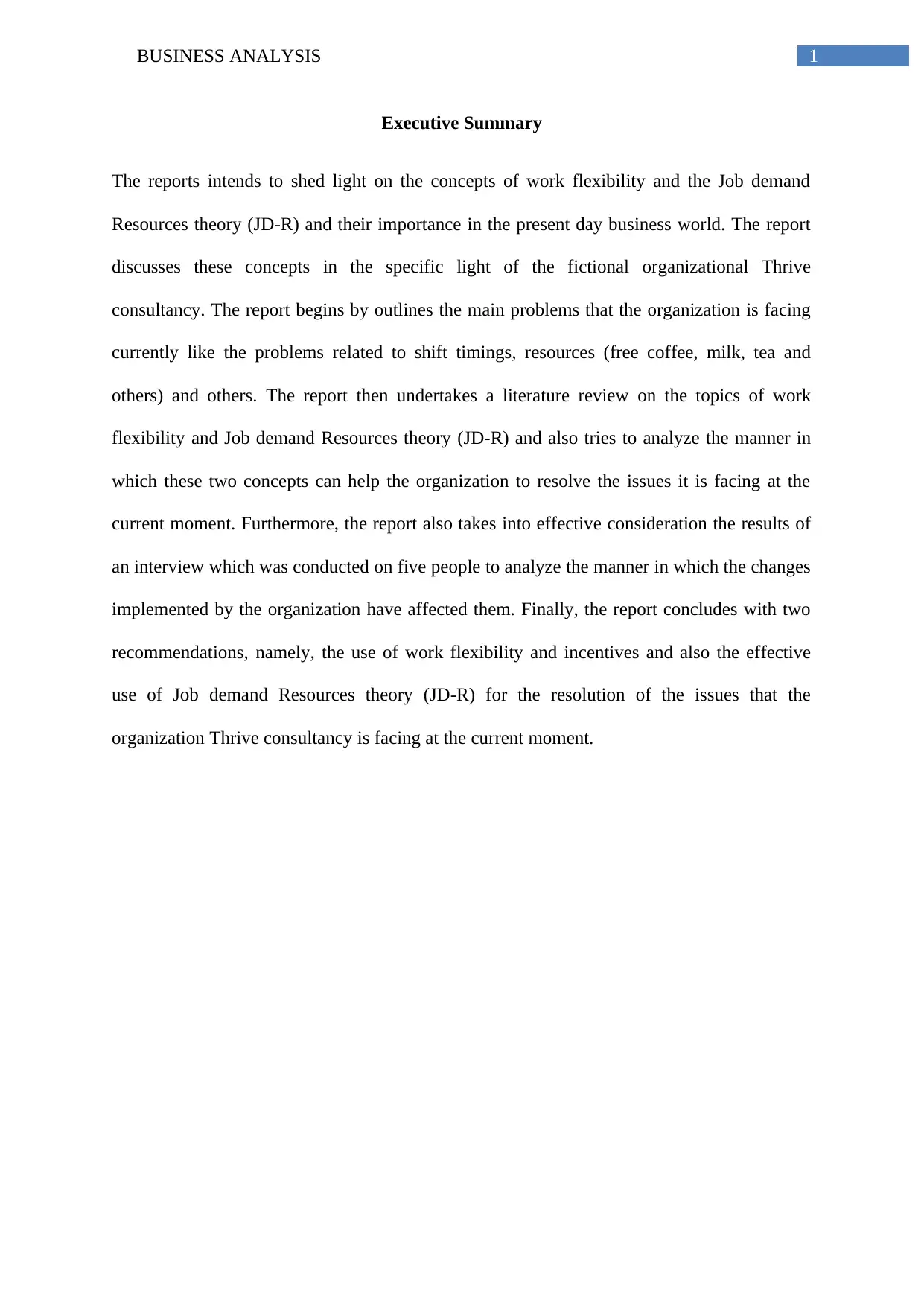
1BUSINESS ANALYSIS
Executive Summary
The reports intends to shed light on the concepts of work flexibility and the Job demand
Resources theory (JD-R) and their importance in the present day business world. The report
discusses these concepts in the specific light of the fictional organizational Thrive
consultancy. The report begins by outlines the main problems that the organization is facing
currently like the problems related to shift timings, resources (free coffee, milk, tea and
others) and others. The report then undertakes a literature review on the topics of work
flexibility and Job demand Resources theory (JD-R) and also tries to analyze the manner in
which these two concepts can help the organization to resolve the issues it is facing at the
current moment. Furthermore, the report also takes into effective consideration the results of
an interview which was conducted on five people to analyze the manner in which the changes
implemented by the organization have affected them. Finally, the report concludes with two
recommendations, namely, the use of work flexibility and incentives and also the effective
use of Job demand Resources theory (JD-R) for the resolution of the issues that the
organization Thrive consultancy is facing at the current moment.
Executive Summary
The reports intends to shed light on the concepts of work flexibility and the Job demand
Resources theory (JD-R) and their importance in the present day business world. The report
discusses these concepts in the specific light of the fictional organizational Thrive
consultancy. The report begins by outlines the main problems that the organization is facing
currently like the problems related to shift timings, resources (free coffee, milk, tea and
others) and others. The report then undertakes a literature review on the topics of work
flexibility and Job demand Resources theory (JD-R) and also tries to analyze the manner in
which these two concepts can help the organization to resolve the issues it is facing at the
current moment. Furthermore, the report also takes into effective consideration the results of
an interview which was conducted on five people to analyze the manner in which the changes
implemented by the organization have affected them. Finally, the report concludes with two
recommendations, namely, the use of work flexibility and incentives and also the effective
use of Job demand Resources theory (JD-R) for the resolution of the issues that the
organization Thrive consultancy is facing at the current moment.
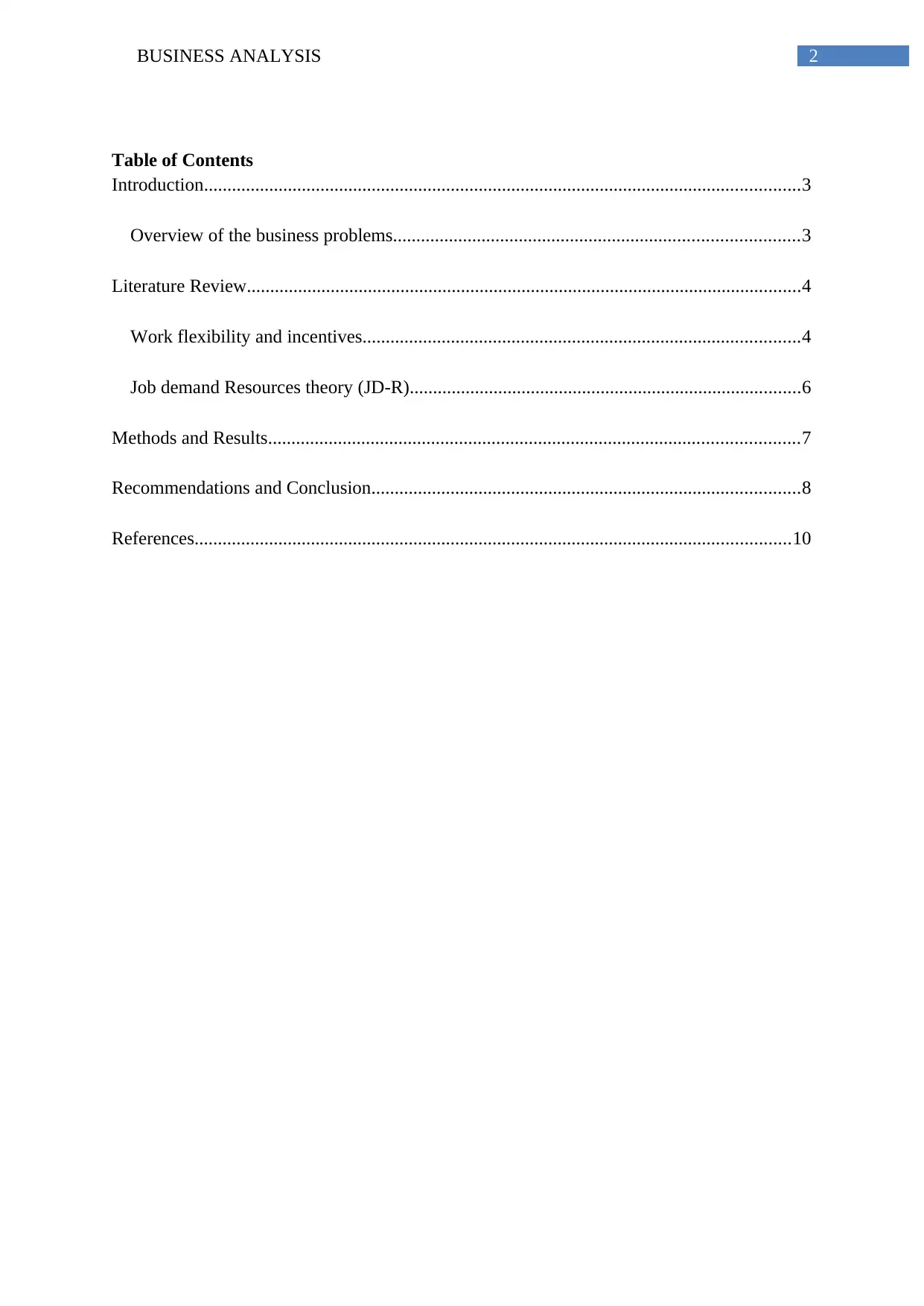
2BUSINESS ANALYSIS
Table of Contents
Introduction................................................................................................................................3
Overview of the business problems.......................................................................................3
Literature Review.......................................................................................................................4
Work flexibility and incentives..............................................................................................4
Job demand Resources theory (JD-R)....................................................................................6
Methods and Results..................................................................................................................7
Recommendations and Conclusion............................................................................................8
References................................................................................................................................10
Table of Contents
Introduction................................................................................................................................3
Overview of the business problems.......................................................................................3
Literature Review.......................................................................................................................4
Work flexibility and incentives..............................................................................................4
Job demand Resources theory (JD-R)....................................................................................6
Methods and Results..................................................................................................................7
Recommendations and Conclusion............................................................................................8
References................................................................................................................................10
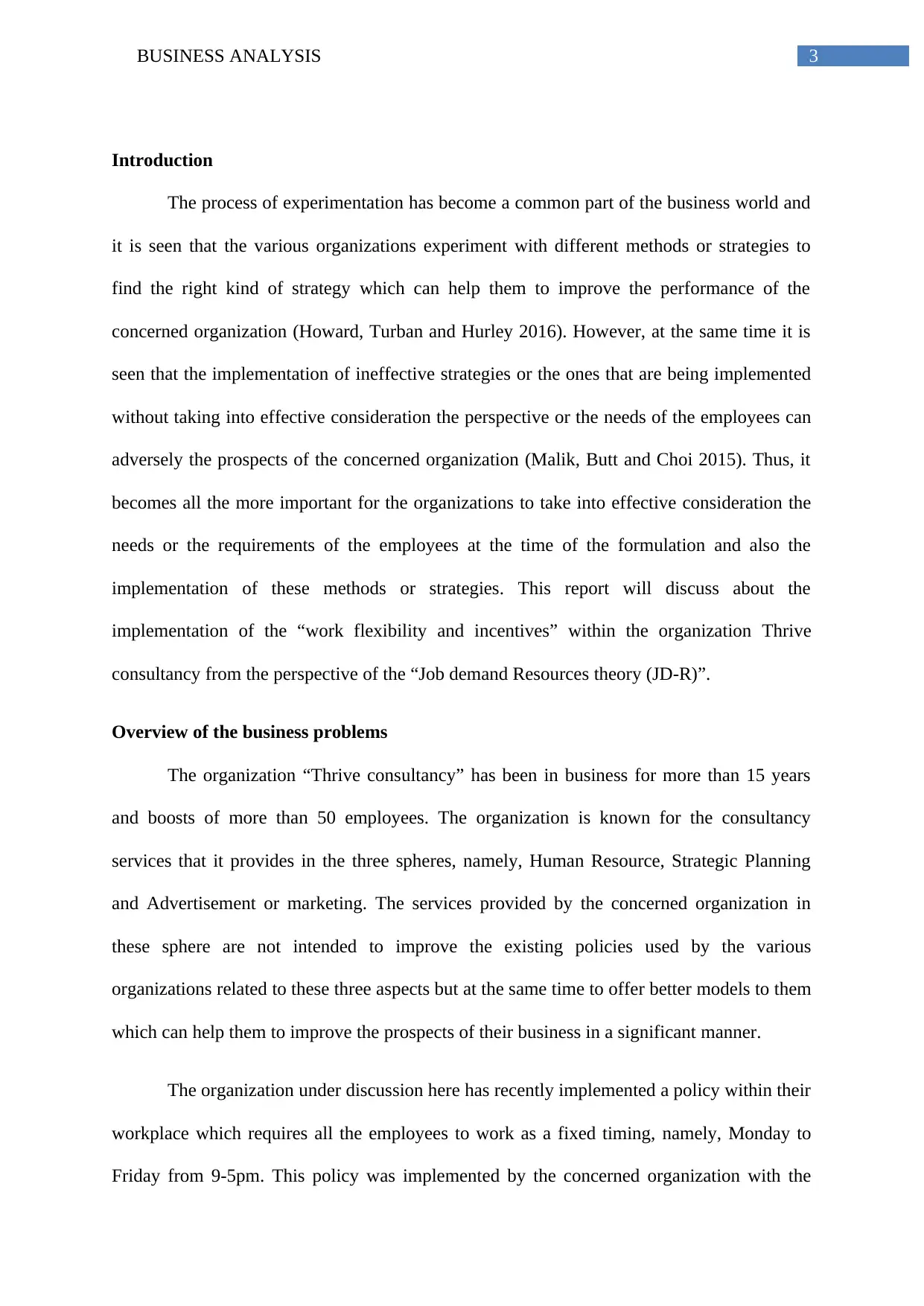
3BUSINESS ANALYSIS
Introduction
The process of experimentation has become a common part of the business world and
it is seen that the various organizations experiment with different methods or strategies to
find the right kind of strategy which can help them to improve the performance of the
concerned organization (Howard, Turban and Hurley 2016). However, at the same time it is
seen that the implementation of ineffective strategies or the ones that are being implemented
without taking into effective consideration the perspective or the needs of the employees can
adversely the prospects of the concerned organization (Malik, Butt and Choi 2015). Thus, it
becomes all the more important for the organizations to take into effective consideration the
needs or the requirements of the employees at the time of the formulation and also the
implementation of these methods or strategies. This report will discuss about the
implementation of the “work flexibility and incentives” within the organization Thrive
consultancy from the perspective of the “Job demand Resources theory (JD-R)”.
Overview of the business problems
The organization “Thrive consultancy” has been in business for more than 15 years
and boosts of more than 50 employees. The organization is known for the consultancy
services that it provides in the three spheres, namely, Human Resource, Strategic Planning
and Advertisement or marketing. The services provided by the concerned organization in
these sphere are not intended to improve the existing policies used by the various
organizations related to these three aspects but at the same time to offer better models to them
which can help them to improve the prospects of their business in a significant manner.
The organization under discussion here has recently implemented a policy within their
workplace which requires all the employees to work as a fixed timing, namely, Monday to
Friday from 9-5pm. This policy was implemented by the concerned organization with the
Introduction
The process of experimentation has become a common part of the business world and
it is seen that the various organizations experiment with different methods or strategies to
find the right kind of strategy which can help them to improve the performance of the
concerned organization (Howard, Turban and Hurley 2016). However, at the same time it is
seen that the implementation of ineffective strategies or the ones that are being implemented
without taking into effective consideration the perspective or the needs of the employees can
adversely the prospects of the concerned organization (Malik, Butt and Choi 2015). Thus, it
becomes all the more important for the organizations to take into effective consideration the
needs or the requirements of the employees at the time of the formulation and also the
implementation of these methods or strategies. This report will discuss about the
implementation of the “work flexibility and incentives” within the organization Thrive
consultancy from the perspective of the “Job demand Resources theory (JD-R)”.
Overview of the business problems
The organization “Thrive consultancy” has been in business for more than 15 years
and boosts of more than 50 employees. The organization is known for the consultancy
services that it provides in the three spheres, namely, Human Resource, Strategic Planning
and Advertisement or marketing. The services provided by the concerned organization in
these sphere are not intended to improve the existing policies used by the various
organizations related to these three aspects but at the same time to offer better models to them
which can help them to improve the prospects of their business in a significant manner.
The organization under discussion here has recently implemented a policy within their
workplace which requires all the employees to work as a fixed timing, namely, Monday to
Friday from 9-5pm. This policy was implemented by the concerned organization with the
Secure Best Marks with AI Grader
Need help grading? Try our AI Grader for instant feedback on your assignments.
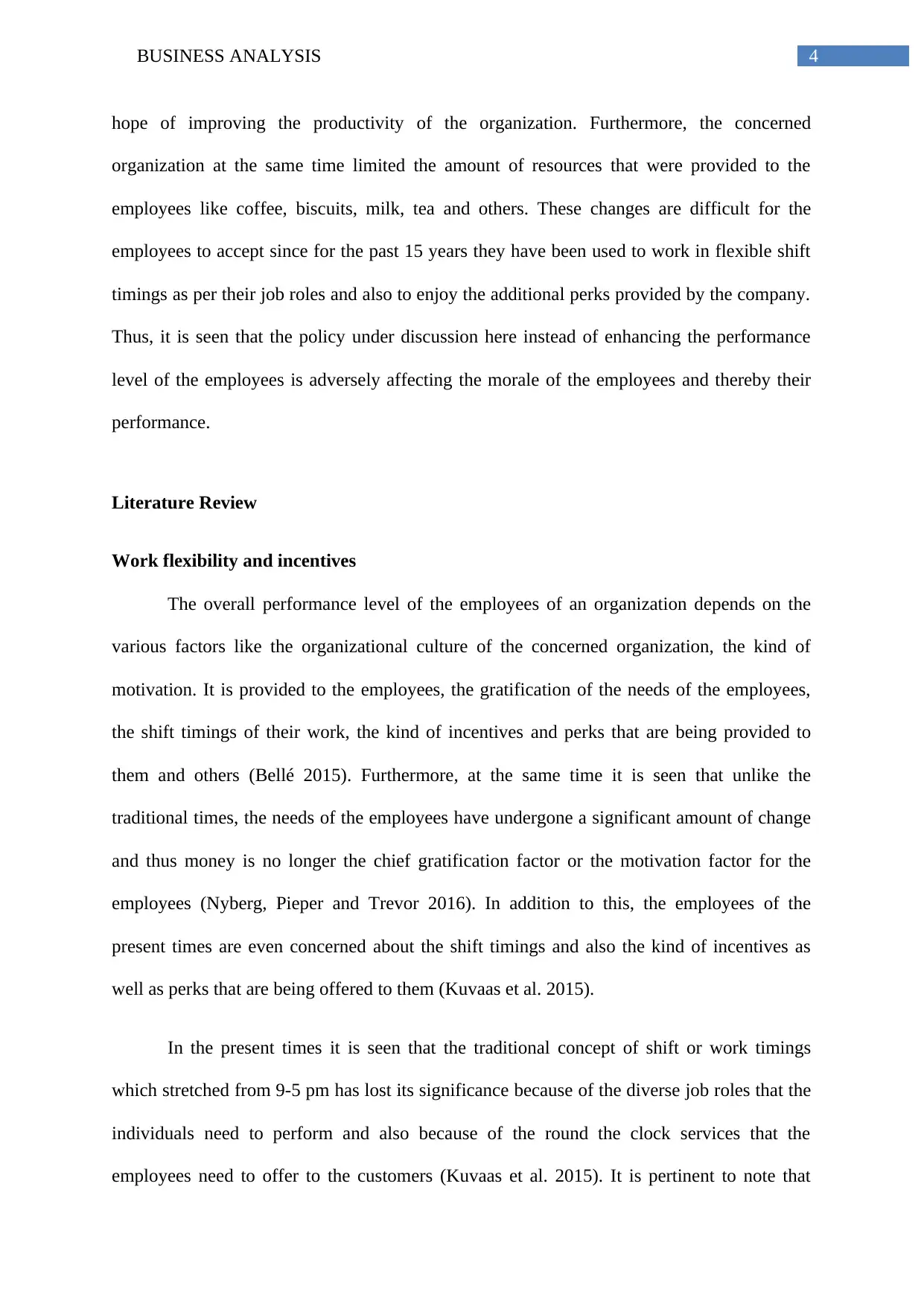
4BUSINESS ANALYSIS
hope of improving the productivity of the organization. Furthermore, the concerned
organization at the same time limited the amount of resources that were provided to the
employees like coffee, biscuits, milk, tea and others. These changes are difficult for the
employees to accept since for the past 15 years they have been used to work in flexible shift
timings as per their job roles and also to enjoy the additional perks provided by the company.
Thus, it is seen that the policy under discussion here instead of enhancing the performance
level of the employees is adversely affecting the morale of the employees and thereby their
performance.
Literature Review
Work flexibility and incentives
The overall performance level of the employees of an organization depends on the
various factors like the organizational culture of the concerned organization, the kind of
motivation. It is provided to the employees, the gratification of the needs of the employees,
the shift timings of their work, the kind of incentives and perks that are being provided to
them and others (Bellé 2015). Furthermore, at the same time it is seen that unlike the
traditional times, the needs of the employees have undergone a significant amount of change
and thus money is no longer the chief gratification factor or the motivation factor for the
employees (Nyberg, Pieper and Trevor 2016). In addition to this, the employees of the
present times are even concerned about the shift timings and also the kind of incentives as
well as perks that are being offered to them (Kuvaas et al. 2015).
In the present times it is seen that the traditional concept of shift or work timings
which stretched from 9-5 pm has lost its significance because of the diverse job roles that the
individuals need to perform and also because of the round the clock services that the
employees need to offer to the customers (Kuvaas et al. 2015). It is pertinent to note that
hope of improving the productivity of the organization. Furthermore, the concerned
organization at the same time limited the amount of resources that were provided to the
employees like coffee, biscuits, milk, tea and others. These changes are difficult for the
employees to accept since for the past 15 years they have been used to work in flexible shift
timings as per their job roles and also to enjoy the additional perks provided by the company.
Thus, it is seen that the policy under discussion here instead of enhancing the performance
level of the employees is adversely affecting the morale of the employees and thereby their
performance.
Literature Review
Work flexibility and incentives
The overall performance level of the employees of an organization depends on the
various factors like the organizational culture of the concerned organization, the kind of
motivation. It is provided to the employees, the gratification of the needs of the employees,
the shift timings of their work, the kind of incentives and perks that are being provided to
them and others (Bellé 2015). Furthermore, at the same time it is seen that unlike the
traditional times, the needs of the employees have undergone a significant amount of change
and thus money is no longer the chief gratification factor or the motivation factor for the
employees (Nyberg, Pieper and Trevor 2016). In addition to this, the employees of the
present times are even concerned about the shift timings and also the kind of incentives as
well as perks that are being offered to them (Kuvaas et al. 2015).
In the present times it is seen that the traditional concept of shift or work timings
which stretched from 9-5 pm has lost its significance because of the diverse job roles that the
individuals need to perform and also because of the round the clock services that the
employees need to offer to the customers (Kuvaas et al. 2015). It is pertinent to note that
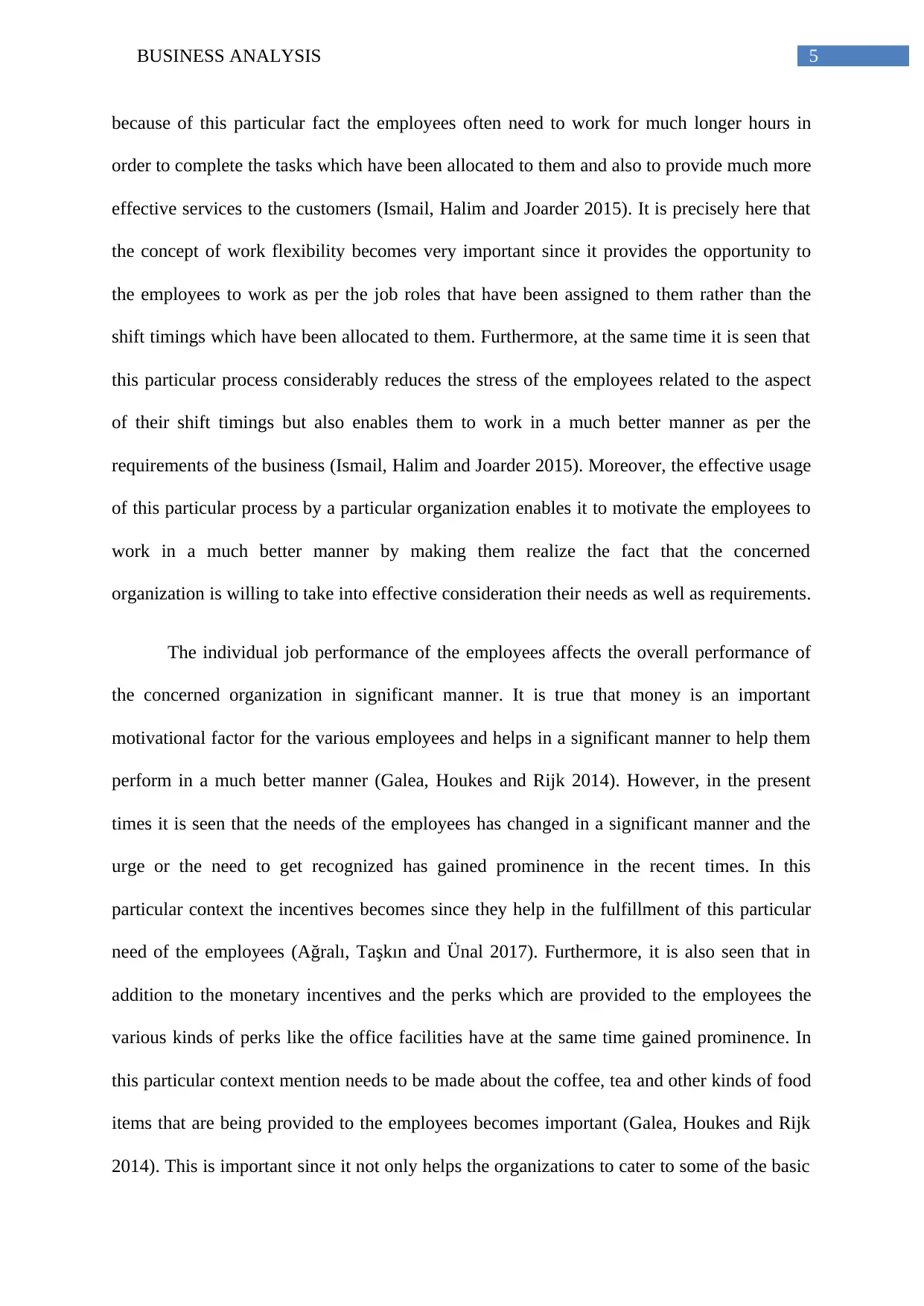
5BUSINESS ANALYSIS
because of this particular fact the employees often need to work for much longer hours in
order to complete the tasks which have been allocated to them and also to provide much more
effective services to the customers (Ismail, Halim and Joarder 2015). It is precisely here that
the concept of work flexibility becomes very important since it provides the opportunity to
the employees to work as per the job roles that have been assigned to them rather than the
shift timings which have been allocated to them. Furthermore, at the same time it is seen that
this particular process considerably reduces the stress of the employees related to the aspect
of their shift timings but also enables them to work in a much better manner as per the
requirements of the business (Ismail, Halim and Joarder 2015). Moreover, the effective usage
of this particular process by a particular organization enables it to motivate the employees to
work in a much better manner by making them realize the fact that the concerned
organization is willing to take into effective consideration their needs as well as requirements.
The individual job performance of the employees affects the overall performance of
the concerned organization in significant manner. It is true that money is an important
motivational factor for the various employees and helps in a significant manner to help them
perform in a much better manner (Galea, Houkes and Rijk 2014). However, in the present
times it is seen that the needs of the employees has changed in a significant manner and the
urge or the need to get recognized has gained prominence in the recent times. In this
particular context the incentives becomes since they help in the fulfillment of this particular
need of the employees (Ağralı, Taşkın and Ünal 2017). Furthermore, it is also seen that in
addition to the monetary incentives and the perks which are provided to the employees the
various kinds of perks like the office facilities have at the same time gained prominence. In
this particular context mention needs to be made about the coffee, tea and other kinds of food
items that are being provided to the employees becomes important (Galea, Houkes and Rijk
2014). This is important since it not only helps the organizations to cater to some of the basic
because of this particular fact the employees often need to work for much longer hours in
order to complete the tasks which have been allocated to them and also to provide much more
effective services to the customers (Ismail, Halim and Joarder 2015). It is precisely here that
the concept of work flexibility becomes very important since it provides the opportunity to
the employees to work as per the job roles that have been assigned to them rather than the
shift timings which have been allocated to them. Furthermore, at the same time it is seen that
this particular process considerably reduces the stress of the employees related to the aspect
of their shift timings but also enables them to work in a much better manner as per the
requirements of the business (Ismail, Halim and Joarder 2015). Moreover, the effective usage
of this particular process by a particular organization enables it to motivate the employees to
work in a much better manner by making them realize the fact that the concerned
organization is willing to take into effective consideration their needs as well as requirements.
The individual job performance of the employees affects the overall performance of
the concerned organization in significant manner. It is true that money is an important
motivational factor for the various employees and helps in a significant manner to help them
perform in a much better manner (Galea, Houkes and Rijk 2014). However, in the present
times it is seen that the needs of the employees has changed in a significant manner and the
urge or the need to get recognized has gained prominence in the recent times. In this
particular context the incentives becomes since they help in the fulfillment of this particular
need of the employees (Ağralı, Taşkın and Ünal 2017). Furthermore, it is also seen that in
addition to the monetary incentives and the perks which are provided to the employees the
various kinds of perks like the office facilities have at the same time gained prominence. In
this particular context mention needs to be made about the coffee, tea and other kinds of food
items that are being provided to the employees becomes important (Galea, Houkes and Rijk
2014). This is important since it not only helps the organizations to cater to some of the basic
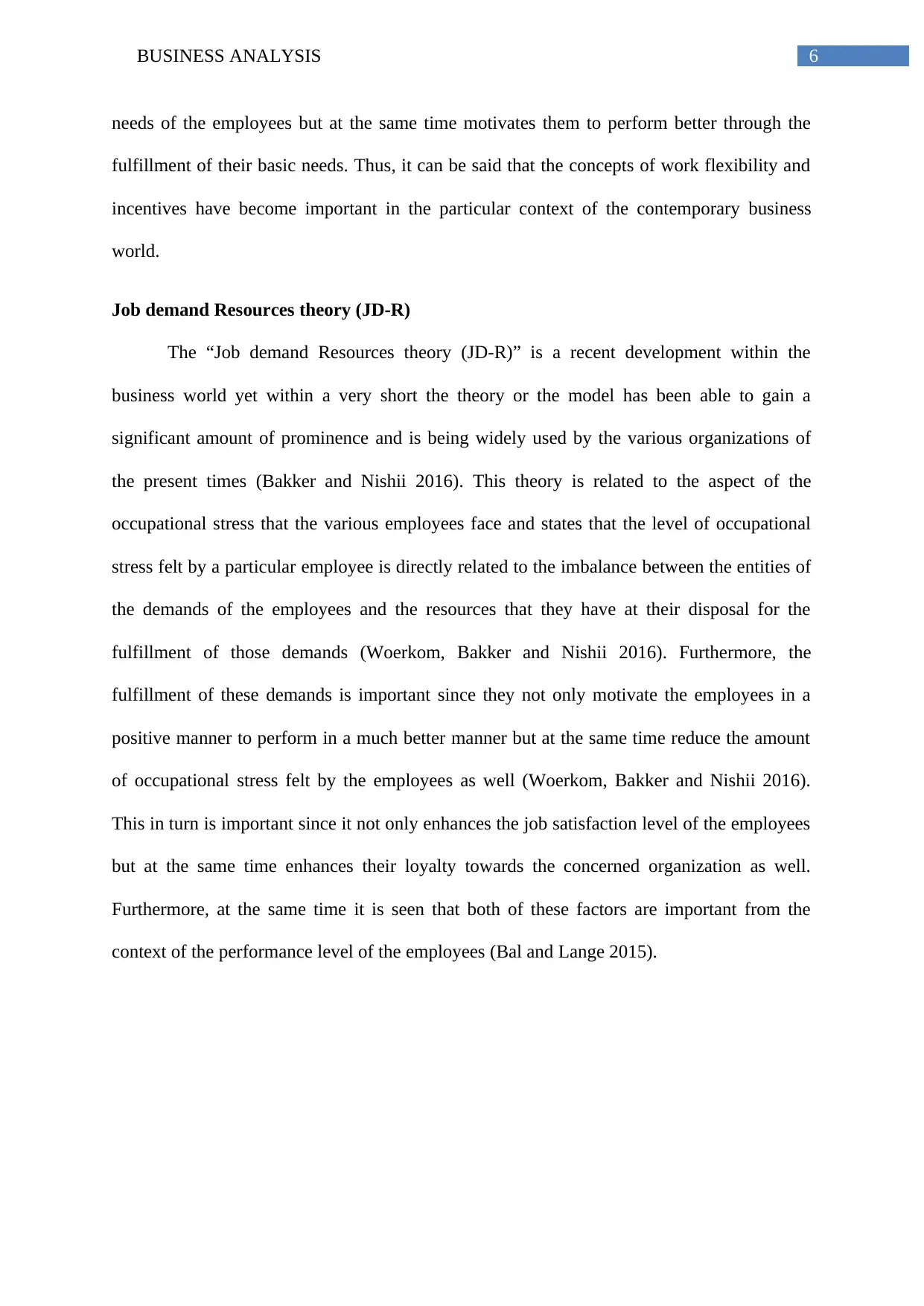
6BUSINESS ANALYSIS
needs of the employees but at the same time motivates them to perform better through the
fulfillment of their basic needs. Thus, it can be said that the concepts of work flexibility and
incentives have become important in the particular context of the contemporary business
world.
Job demand Resources theory (JD-R)
The “Job demand Resources theory (JD-R)” is a recent development within the
business world yet within a very short the theory or the model has been able to gain a
significant amount of prominence and is being widely used by the various organizations of
the present times (Bakker and Nishii 2016). This theory is related to the aspect of the
occupational stress that the various employees face and states that the level of occupational
stress felt by a particular employee is directly related to the imbalance between the entities of
the demands of the employees and the resources that they have at their disposal for the
fulfillment of those demands (Woerkom, Bakker and Nishii 2016). Furthermore, the
fulfillment of these demands is important since they not only motivate the employees in a
positive manner to perform in a much better manner but at the same time reduce the amount
of occupational stress felt by the employees as well (Woerkom, Bakker and Nishii 2016).
This in turn is important since it not only enhances the job satisfaction level of the employees
but at the same time enhances their loyalty towards the concerned organization as well.
Furthermore, at the same time it is seen that both of these factors are important from the
context of the performance level of the employees (Bal and Lange 2015).
needs of the employees but at the same time motivates them to perform better through the
fulfillment of their basic needs. Thus, it can be said that the concepts of work flexibility and
incentives have become important in the particular context of the contemporary business
world.
Job demand Resources theory (JD-R)
The “Job demand Resources theory (JD-R)” is a recent development within the
business world yet within a very short the theory or the model has been able to gain a
significant amount of prominence and is being widely used by the various organizations of
the present times (Bakker and Nishii 2016). This theory is related to the aspect of the
occupational stress that the various employees face and states that the level of occupational
stress felt by a particular employee is directly related to the imbalance between the entities of
the demands of the employees and the resources that they have at their disposal for the
fulfillment of those demands (Woerkom, Bakker and Nishii 2016). Furthermore, the
fulfillment of these demands is important since they not only motivate the employees in a
positive manner to perform in a much better manner but at the same time reduce the amount
of occupational stress felt by the employees as well (Woerkom, Bakker and Nishii 2016).
This in turn is important since it not only enhances the job satisfaction level of the employees
but at the same time enhances their loyalty towards the concerned organization as well.
Furthermore, at the same time it is seen that both of these factors are important from the
context of the performance level of the employees (Bal and Lange 2015).
Paraphrase This Document
Need a fresh take? Get an instant paraphrase of this document with our AI Paraphraser
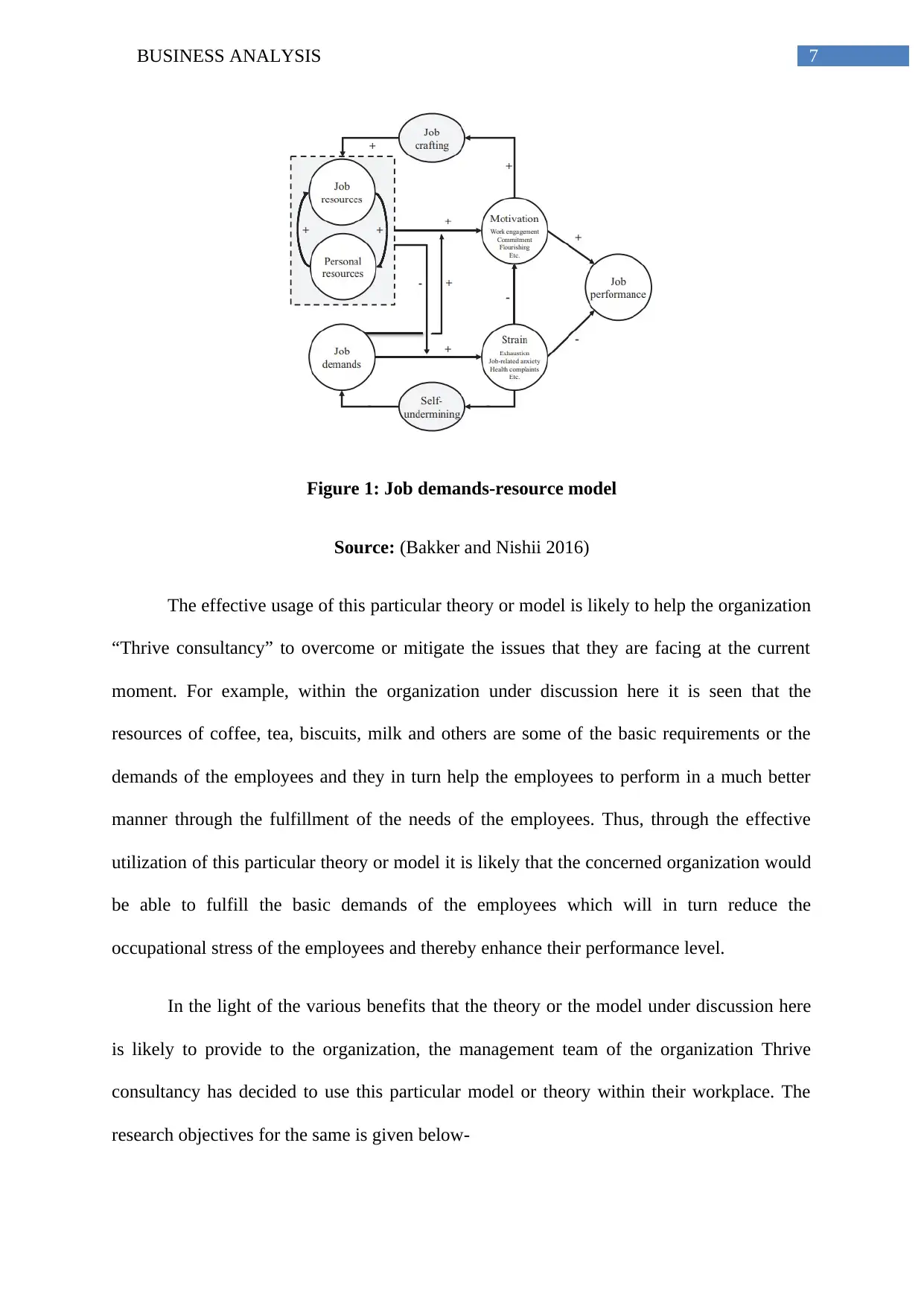
7BUSINESS ANALYSIS
Figure 1: Job demands-resource model
Source: (Bakker and Nishii 2016)
The effective usage of this particular theory or model is likely to help the organization
“Thrive consultancy” to overcome or mitigate the issues that they are facing at the current
moment. For example, within the organization under discussion here it is seen that the
resources of coffee, tea, biscuits, milk and others are some of the basic requirements or the
demands of the employees and they in turn help the employees to perform in a much better
manner through the fulfillment of the needs of the employees. Thus, through the effective
utilization of this particular theory or model it is likely that the concerned organization would
be able to fulfill the basic demands of the employees which will in turn reduce the
occupational stress of the employees and thereby enhance their performance level.
In the light of the various benefits that the theory or the model under discussion here
is likely to provide to the organization, the management team of the organization Thrive
consultancy has decided to use this particular model or theory within their workplace. The
research objectives for the same is given below-
Figure 1: Job demands-resource model
Source: (Bakker and Nishii 2016)
The effective usage of this particular theory or model is likely to help the organization
“Thrive consultancy” to overcome or mitigate the issues that they are facing at the current
moment. For example, within the organization under discussion here it is seen that the
resources of coffee, tea, biscuits, milk and others are some of the basic requirements or the
demands of the employees and they in turn help the employees to perform in a much better
manner through the fulfillment of the needs of the employees. Thus, through the effective
utilization of this particular theory or model it is likely that the concerned organization would
be able to fulfill the basic demands of the employees which will in turn reduce the
occupational stress of the employees and thereby enhance their performance level.
In the light of the various benefits that the theory or the model under discussion here
is likely to provide to the organization, the management team of the organization Thrive
consultancy has decided to use this particular model or theory within their workplace. The
research objectives for the same is given below-
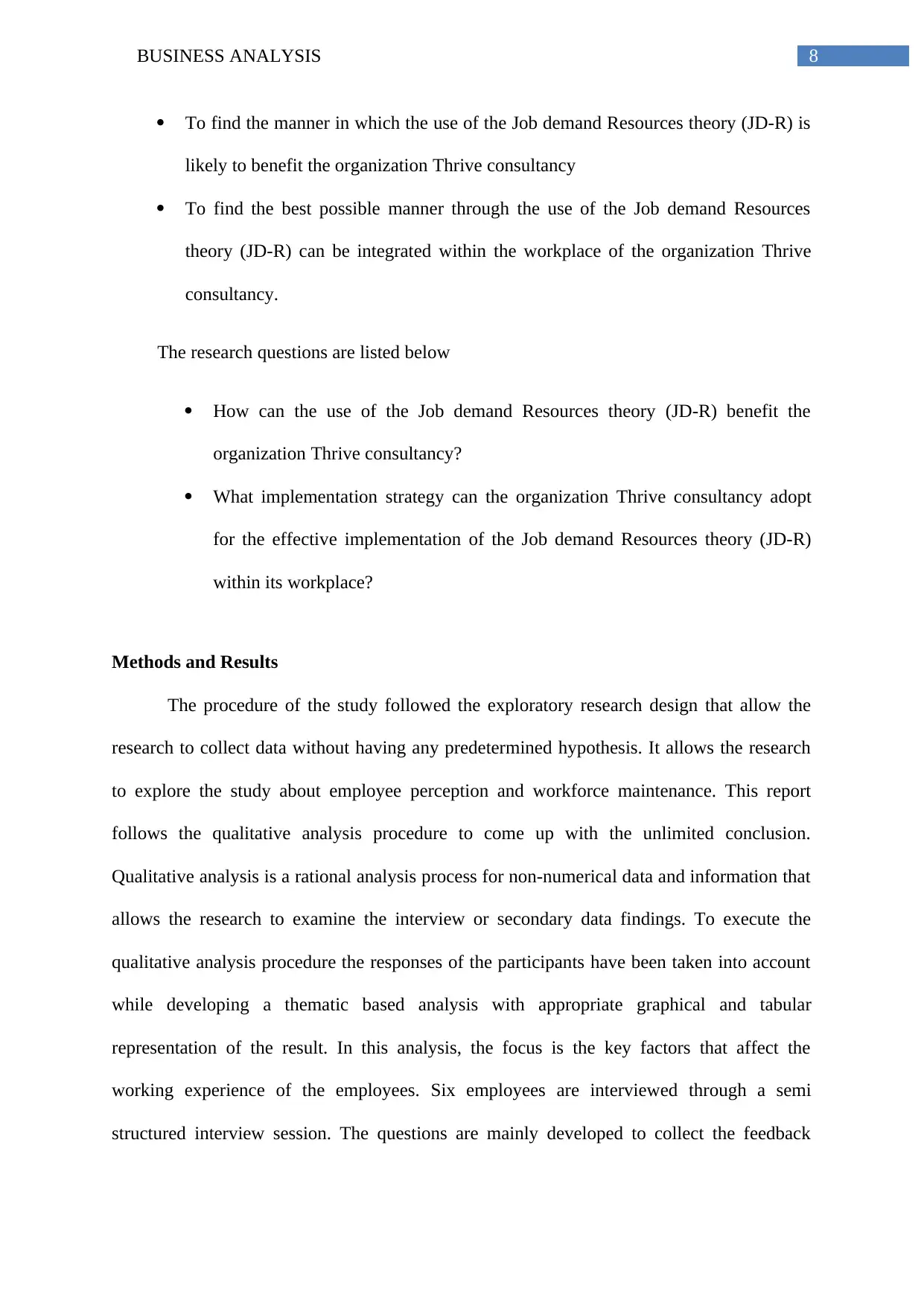
8BUSINESS ANALYSIS
To find the manner in which the use of the Job demand Resources theory (JD-R) is
likely to benefit the organization Thrive consultancy
To find the best possible manner through the use of the Job demand Resources
theory (JD-R) can be integrated within the workplace of the organization Thrive
consultancy.
The research questions are listed below
How can the use of the Job demand Resources theory (JD-R) benefit the
organization Thrive consultancy?
What implementation strategy can the organization Thrive consultancy adopt
for the effective implementation of the Job demand Resources theory (JD-R)
within its workplace?
Methods and Results
The procedure of the study followed the exploratory research design that allow the
research to collect data without having any predetermined hypothesis. It allows the research
to explore the study about employee perception and workforce maintenance. This report
follows the qualitative analysis procedure to come up with the unlimited conclusion.
Qualitative analysis is a rational analysis process for non-numerical data and information that
allows the research to examine the interview or secondary data findings. To execute the
qualitative analysis procedure the responses of the participants have been taken into account
while developing a thematic based analysis with appropriate graphical and tabular
representation of the result. In this analysis, the focus is the key factors that affect the
working experience of the employees. Six employees are interviewed through a semi
structured interview session. The questions are mainly developed to collect the feedback
To find the manner in which the use of the Job demand Resources theory (JD-R) is
likely to benefit the organization Thrive consultancy
To find the best possible manner through the use of the Job demand Resources
theory (JD-R) can be integrated within the workplace of the organization Thrive
consultancy.
The research questions are listed below
How can the use of the Job demand Resources theory (JD-R) benefit the
organization Thrive consultancy?
What implementation strategy can the organization Thrive consultancy adopt
for the effective implementation of the Job demand Resources theory (JD-R)
within its workplace?
Methods and Results
The procedure of the study followed the exploratory research design that allow the
research to collect data without having any predetermined hypothesis. It allows the research
to explore the study about employee perception and workforce maintenance. This report
follows the qualitative analysis procedure to come up with the unlimited conclusion.
Qualitative analysis is a rational analysis process for non-numerical data and information that
allows the research to examine the interview or secondary data findings. To execute the
qualitative analysis procedure the responses of the participants have been taken into account
while developing a thematic based analysis with appropriate graphical and tabular
representation of the result. In this analysis, the focus is the key factors that affect the
working experience of the employees. Six employees are interviewed through a semi
structured interview session. The questions are mainly developed to collect the feedback
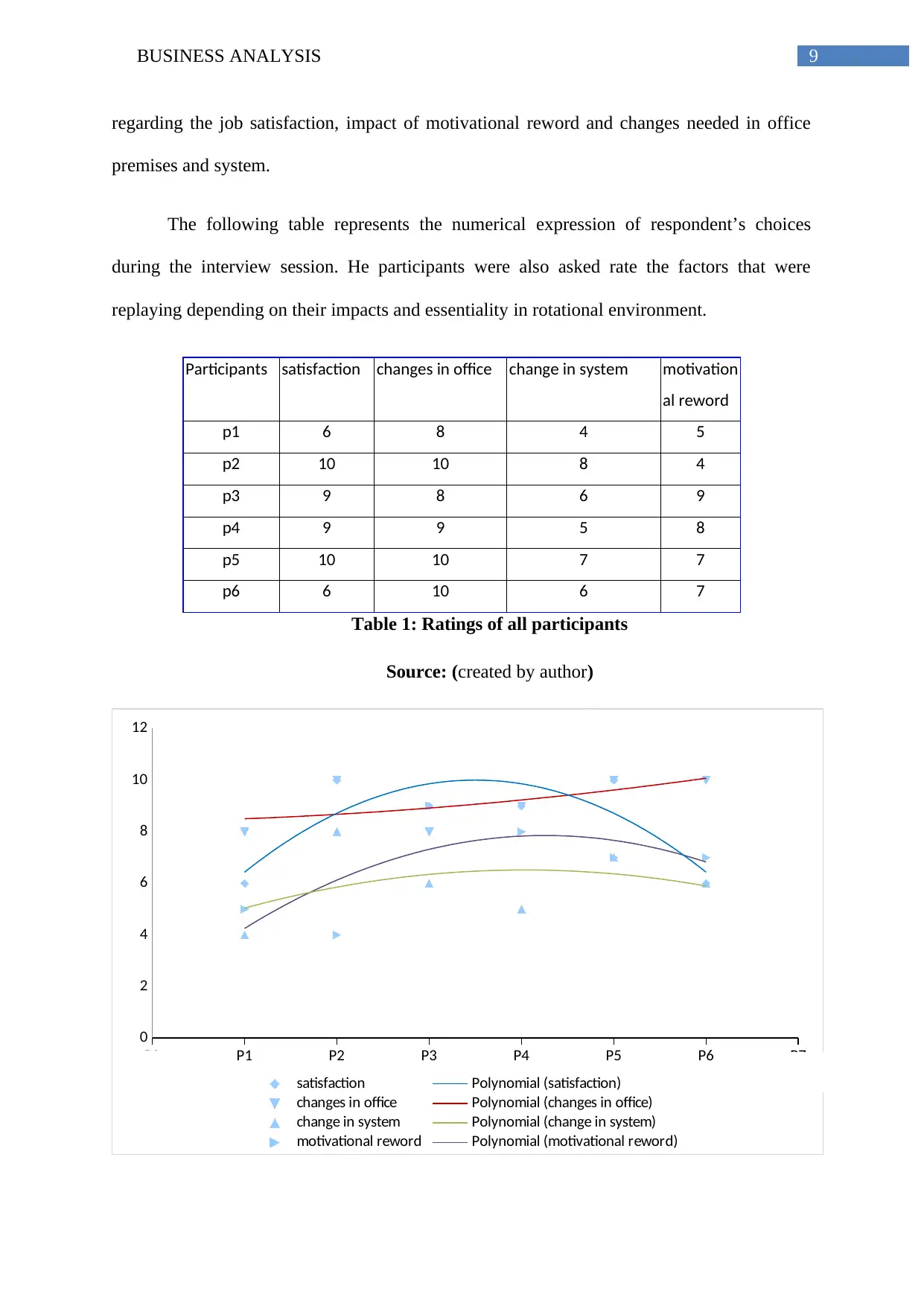
9BUSINESS ANALYSIS
regarding the job satisfaction, impact of motivational reword and changes needed in office
premises and system.
The following table represents the numerical expression of respondent’s choices
during the interview session. He participants were also asked rate the factors that were
replaying depending on their impacts and essentiality in rotational environment.
Participants satisfaction changes in office change in system motivation
al reword
p1 6 8 4 5
p2 10 10 8 4
p3 9 8 6 9
p4 9 9 5 8
p5 10 10 7 7
p6 6 10 6 7
Table 1: Ratings of all participants
Source: (created by author)
P0 P1 P2 P3 P4 P5 P6 P7
0
2
4
6
8
10
12
satisfaction Polynomial (satisfaction)
changes in office Polynomial (changes in office)
change in system Polynomial (change in system)
motivational reword Polynomial (motivational reword)
regarding the job satisfaction, impact of motivational reword and changes needed in office
premises and system.
The following table represents the numerical expression of respondent’s choices
during the interview session. He participants were also asked rate the factors that were
replaying depending on their impacts and essentiality in rotational environment.
Participants satisfaction changes in office change in system motivation
al reword
p1 6 8 4 5
p2 10 10 8 4
p3 9 8 6 9
p4 9 9 5 8
p5 10 10 7 7
p6 6 10 6 7
Table 1: Ratings of all participants
Source: (created by author)
P0 P1 P2 P3 P4 P5 P6 P7
0
2
4
6
8
10
12
satisfaction Polynomial (satisfaction)
changes in office Polynomial (changes in office)
change in system Polynomial (change in system)
motivational reword Polynomial (motivational reword)
Secure Best Marks with AI Grader
Need help grading? Try our AI Grader for instant feedback on your assignments.
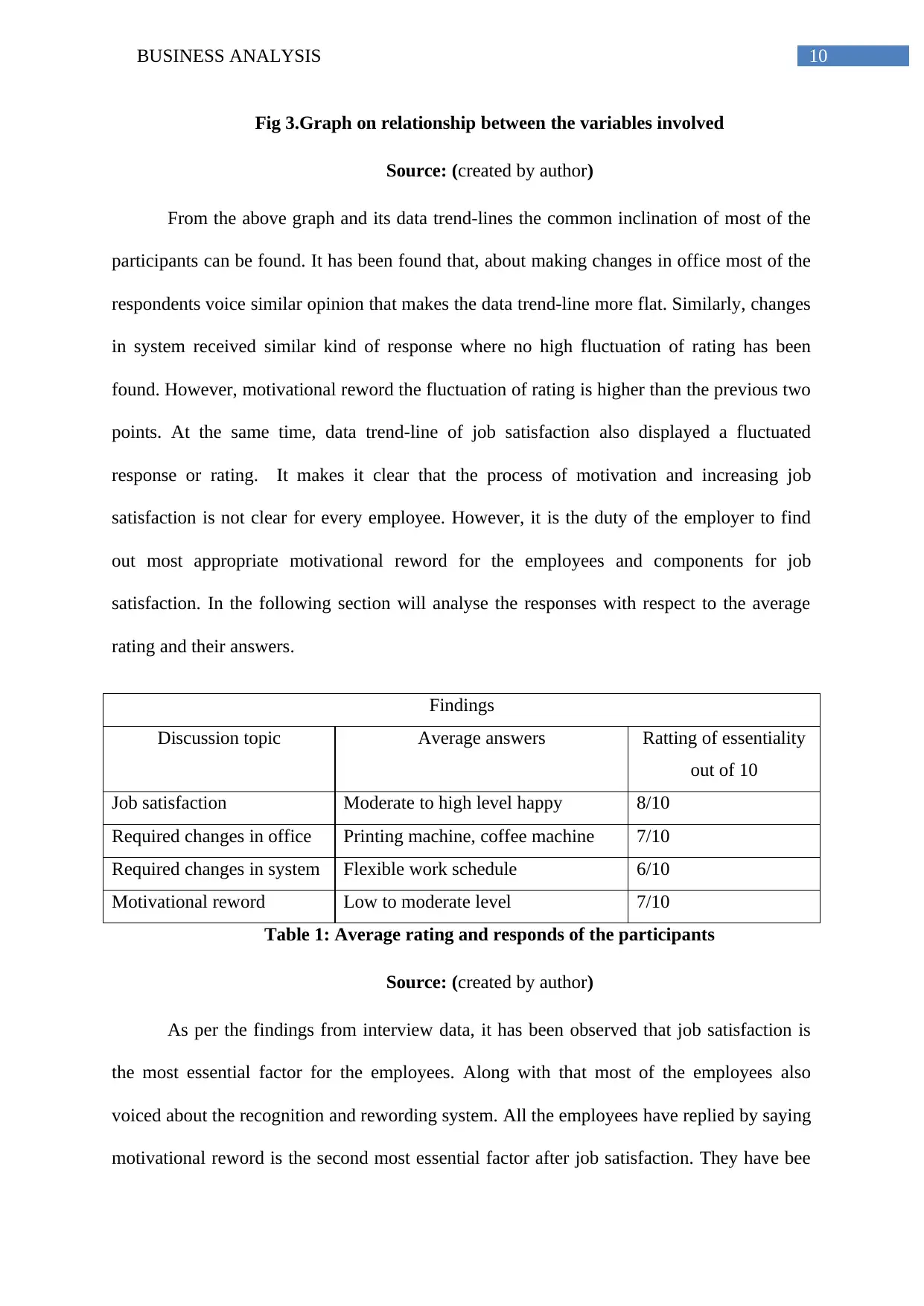
10BUSINESS ANALYSIS
Fig 3.Graph on relationship between the variables involved
Source: (created by author)
From the above graph and its data trend-lines the common inclination of most of the
participants can be found. It has been found that, about making changes in office most of the
respondents voice similar opinion that makes the data trend-line more flat. Similarly, changes
in system received similar kind of response where no high fluctuation of rating has been
found. However, motivational reword the fluctuation of rating is higher than the previous two
points. At the same time, data trend-line of job satisfaction also displayed a fluctuated
response or rating. It makes it clear that the process of motivation and increasing job
satisfaction is not clear for every employee. However, it is the duty of the employer to find
out most appropriate motivational reword for the employees and components for job
satisfaction. In the following section will analyse the responses with respect to the average
rating and their answers.
Findings
Discussion topic Average answers Ratting of essentiality
out of 10
Job satisfaction Moderate to high level happy 8/10
Required changes in office Printing machine, coffee machine 7/10
Required changes in system Flexible work schedule 6/10
Motivational reword Low to moderate level 7/10
Table 1: Average rating and responds of the participants
Source: (created by author)
As per the findings from interview data, it has been observed that job satisfaction is
the most essential factor for the employees. Along with that most of the employees also
voiced about the recognition and rewording system. All the employees have replied by saying
motivational reword is the second most essential factor after job satisfaction. They have bee
Fig 3.Graph on relationship between the variables involved
Source: (created by author)
From the above graph and its data trend-lines the common inclination of most of the
participants can be found. It has been found that, about making changes in office most of the
respondents voice similar opinion that makes the data trend-line more flat. Similarly, changes
in system received similar kind of response where no high fluctuation of rating has been
found. However, motivational reword the fluctuation of rating is higher than the previous two
points. At the same time, data trend-line of job satisfaction also displayed a fluctuated
response or rating. It makes it clear that the process of motivation and increasing job
satisfaction is not clear for every employee. However, it is the duty of the employer to find
out most appropriate motivational reword for the employees and components for job
satisfaction. In the following section will analyse the responses with respect to the average
rating and their answers.
Findings
Discussion topic Average answers Ratting of essentiality
out of 10
Job satisfaction Moderate to high level happy 8/10
Required changes in office Printing machine, coffee machine 7/10
Required changes in system Flexible work schedule 6/10
Motivational reword Low to moderate level 7/10
Table 1: Average rating and responds of the participants
Source: (created by author)
As per the findings from interview data, it has been observed that job satisfaction is
the most essential factor for the employees. Along with that most of the employees also
voiced about the recognition and rewording system. All the employees have replied by saying
motivational reword is the second most essential factor after job satisfaction. They have bee
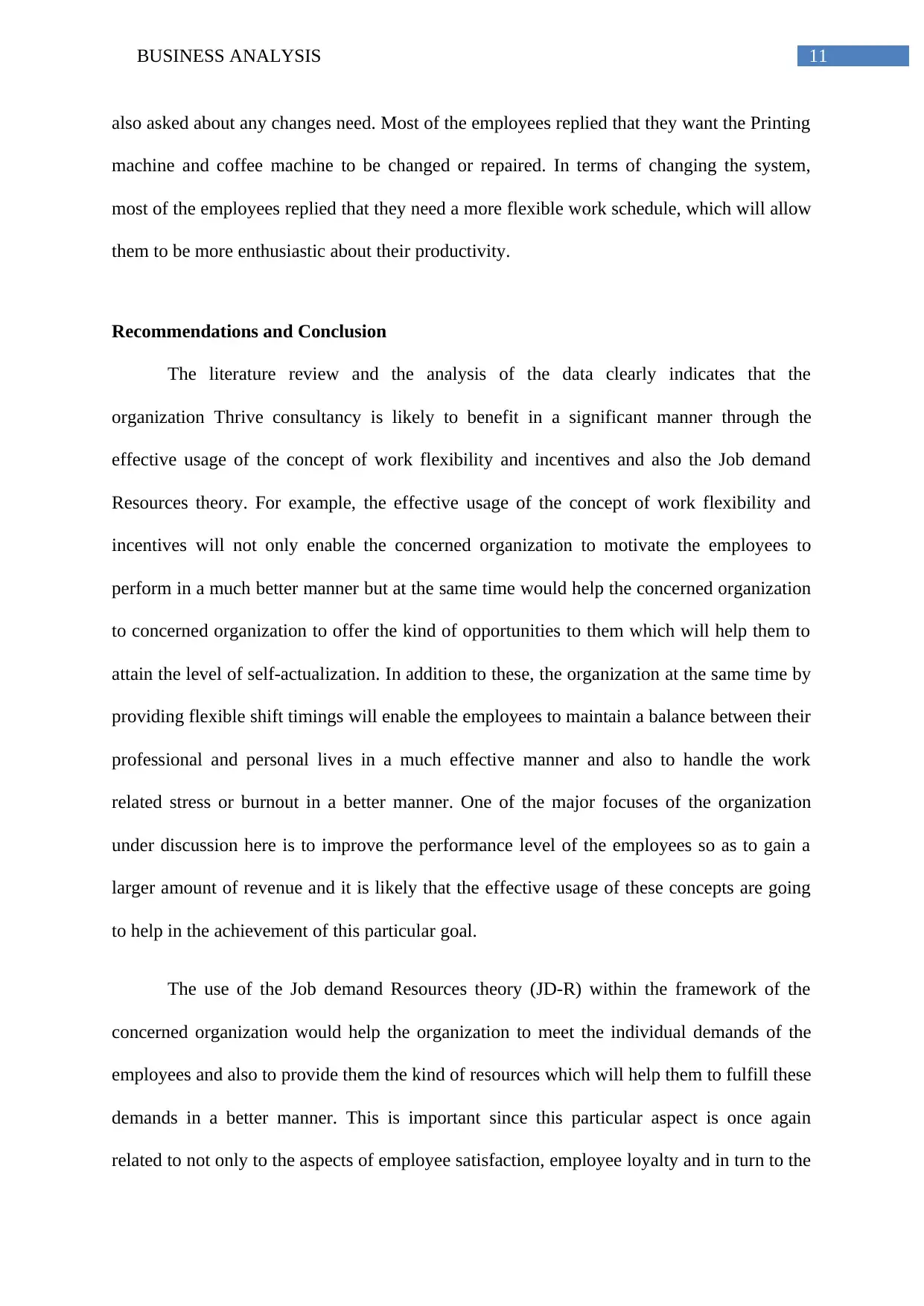
11BUSINESS ANALYSIS
also asked about any changes need. Most of the employees replied that they want the Printing
machine and coffee machine to be changed or repaired. In terms of changing the system,
most of the employees replied that they need a more flexible work schedule, which will allow
them to be more enthusiastic about their productivity.
Recommendations and Conclusion
The literature review and the analysis of the data clearly indicates that the
organization Thrive consultancy is likely to benefit in a significant manner through the
effective usage of the concept of work flexibility and incentives and also the Job demand
Resources theory. For example, the effective usage of the concept of work flexibility and
incentives will not only enable the concerned organization to motivate the employees to
perform in a much better manner but at the same time would help the concerned organization
to concerned organization to offer the kind of opportunities to them which will help them to
attain the level of self-actualization. In addition to these, the organization at the same time by
providing flexible shift timings will enable the employees to maintain a balance between their
professional and personal lives in a much effective manner and also to handle the work
related stress or burnout in a better manner. One of the major focuses of the organization
under discussion here is to improve the performance level of the employees so as to gain a
larger amount of revenue and it is likely that the effective usage of these concepts are going
to help in the achievement of this particular goal.
The use of the Job demand Resources theory (JD-R) within the framework of the
concerned organization would help the organization to meet the individual demands of the
employees and also to provide them the kind of resources which will help them to fulfill these
demands in a better manner. This is important since this particular aspect is once again
related to not only to the aspects of employee satisfaction, employee loyalty and in turn to the
also asked about any changes need. Most of the employees replied that they want the Printing
machine and coffee machine to be changed or repaired. In terms of changing the system,
most of the employees replied that they need a more flexible work schedule, which will allow
them to be more enthusiastic about their productivity.
Recommendations and Conclusion
The literature review and the analysis of the data clearly indicates that the
organization Thrive consultancy is likely to benefit in a significant manner through the
effective usage of the concept of work flexibility and incentives and also the Job demand
Resources theory. For example, the effective usage of the concept of work flexibility and
incentives will not only enable the concerned organization to motivate the employees to
perform in a much better manner but at the same time would help the concerned organization
to concerned organization to offer the kind of opportunities to them which will help them to
attain the level of self-actualization. In addition to these, the organization at the same time by
providing flexible shift timings will enable the employees to maintain a balance between their
professional and personal lives in a much effective manner and also to handle the work
related stress or burnout in a better manner. One of the major focuses of the organization
under discussion here is to improve the performance level of the employees so as to gain a
larger amount of revenue and it is likely that the effective usage of these concepts are going
to help in the achievement of this particular goal.
The use of the Job demand Resources theory (JD-R) within the framework of the
concerned organization would help the organization to meet the individual demands of the
employees and also to provide them the kind of resources which will help them to fulfill these
demands in a better manner. This is important since this particular aspect is once again
related to not only to the aspects of employee satisfaction, employee loyalty and in turn to the
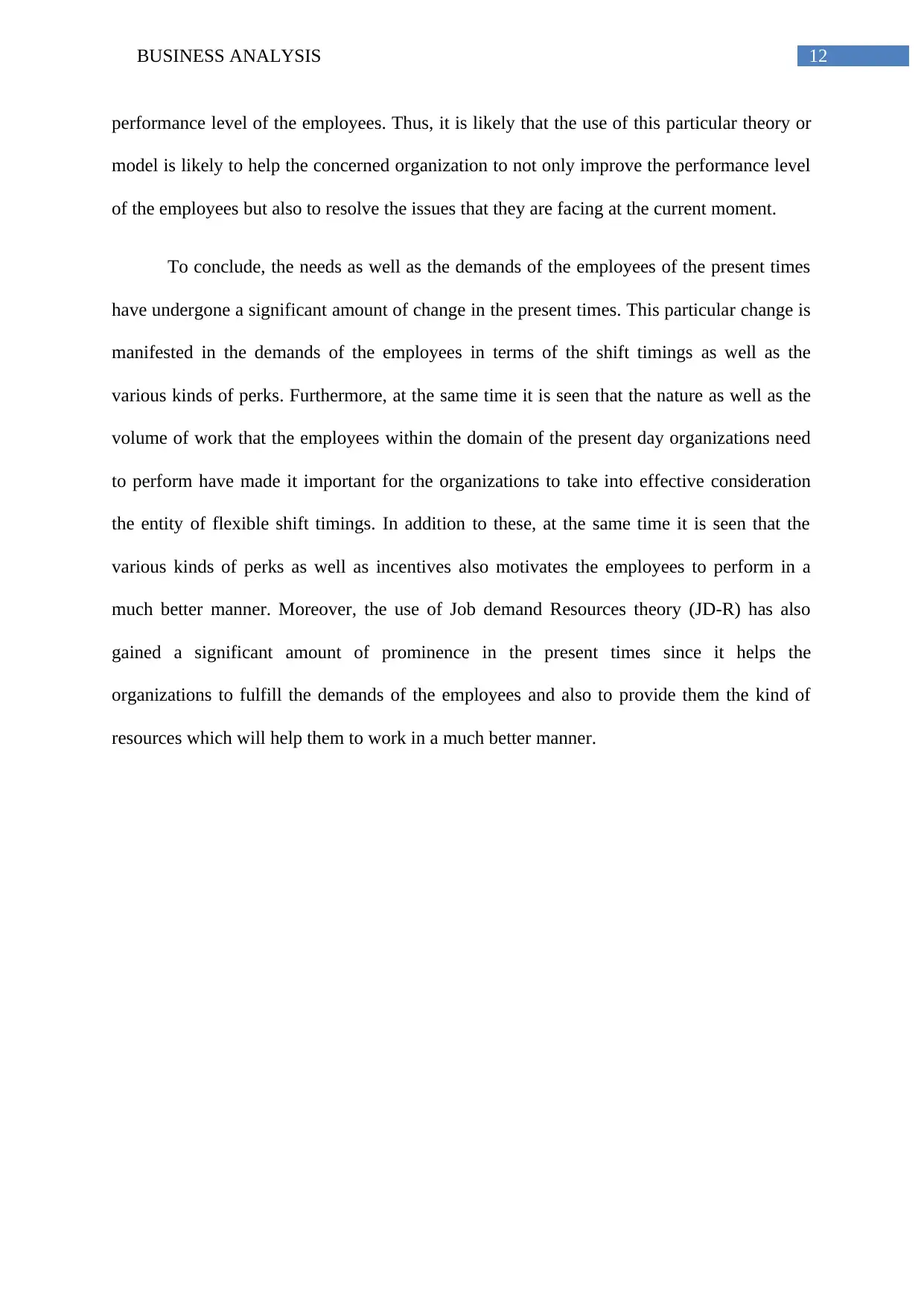
12BUSINESS ANALYSIS
performance level of the employees. Thus, it is likely that the use of this particular theory or
model is likely to help the concerned organization to not only improve the performance level
of the employees but also to resolve the issues that they are facing at the current moment.
To conclude, the needs as well as the demands of the employees of the present times
have undergone a significant amount of change in the present times. This particular change is
manifested in the demands of the employees in terms of the shift timings as well as the
various kinds of perks. Furthermore, at the same time it is seen that the nature as well as the
volume of work that the employees within the domain of the present day organizations need
to perform have made it important for the organizations to take into effective consideration
the entity of flexible shift timings. In addition to these, at the same time it is seen that the
various kinds of perks as well as incentives also motivates the employees to perform in a
much better manner. Moreover, the use of Job demand Resources theory (JD-R) has also
gained a significant amount of prominence in the present times since it helps the
organizations to fulfill the demands of the employees and also to provide them the kind of
resources which will help them to work in a much better manner.
performance level of the employees. Thus, it is likely that the use of this particular theory or
model is likely to help the concerned organization to not only improve the performance level
of the employees but also to resolve the issues that they are facing at the current moment.
To conclude, the needs as well as the demands of the employees of the present times
have undergone a significant amount of change in the present times. This particular change is
manifested in the demands of the employees in terms of the shift timings as well as the
various kinds of perks. Furthermore, at the same time it is seen that the nature as well as the
volume of work that the employees within the domain of the present day organizations need
to perform have made it important for the organizations to take into effective consideration
the entity of flexible shift timings. In addition to these, at the same time it is seen that the
various kinds of perks as well as incentives also motivates the employees to perform in a
much better manner. Moreover, the use of Job demand Resources theory (JD-R) has also
gained a significant amount of prominence in the present times since it helps the
organizations to fulfill the demands of the employees and also to provide them the kind of
resources which will help them to work in a much better manner.
Paraphrase This Document
Need a fresh take? Get an instant paraphrase of this document with our AI Paraphraser
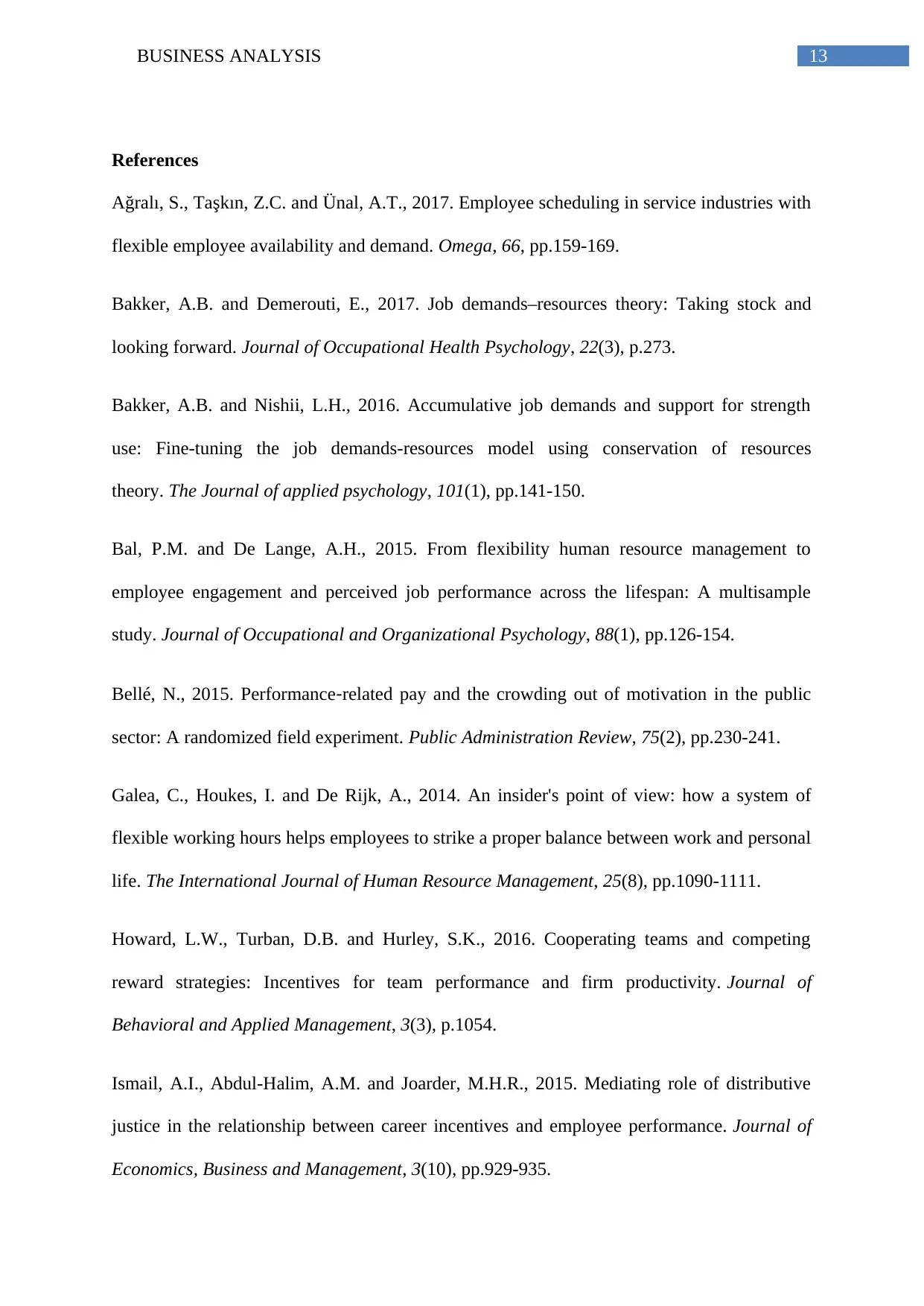
13BUSINESS ANALYSIS
References
Ağralı, S., Taşkın, Z.C. and Ünal, A.T., 2017. Employee scheduling in service industries with
flexible employee availability and demand. Omega, 66, pp.159-169.
Bakker, A.B. and Demerouti, E., 2017. Job demands–resources theory: Taking stock and
looking forward. Journal of Occupational Health Psychology, 22(3), p.273.
Bakker, A.B. and Nishii, L.H., 2016. Accumulative job demands and support for strength
use: Fine-tuning the job demands-resources model using conservation of resources
theory. The Journal of applied psychology, 101(1), pp.141-150.
Bal, P.M. and De Lange, A.H., 2015. From flexibility human resource management to
employee engagement and perceived job performance across the lifespan: A multisample
study. Journal of Occupational and Organizational Psychology, 88(1), pp.126-154.
Bellé, N., 2015. Performance‐related pay and the crowding out of motivation in the public
sector: A randomized field experiment. Public Administration Review, 75(2), pp.230-241.
Galea, C., Houkes, I. and De Rijk, A., 2014. An insider's point of view: how a system of
flexible working hours helps employees to strike a proper balance between work and personal
life. The International Journal of Human Resource Management, 25(8), pp.1090-1111.
Howard, L.W., Turban, D.B. and Hurley, S.K., 2016. Cooperating teams and competing
reward strategies: Incentives for team performance and firm productivity. Journal of
Behavioral and Applied Management, 3(3), p.1054.
Ismail, A.I., Abdul-Halim, A.M. and Joarder, M.H.R., 2015. Mediating role of distributive
justice in the relationship between career incentives and employee performance. Journal of
Economics, Business and Management, 3(10), pp.929-935.
References
Ağralı, S., Taşkın, Z.C. and Ünal, A.T., 2017. Employee scheduling in service industries with
flexible employee availability and demand. Omega, 66, pp.159-169.
Bakker, A.B. and Demerouti, E., 2017. Job demands–resources theory: Taking stock and
looking forward. Journal of Occupational Health Psychology, 22(3), p.273.
Bakker, A.B. and Nishii, L.H., 2016. Accumulative job demands and support for strength
use: Fine-tuning the job demands-resources model using conservation of resources
theory. The Journal of applied psychology, 101(1), pp.141-150.
Bal, P.M. and De Lange, A.H., 2015. From flexibility human resource management to
employee engagement and perceived job performance across the lifespan: A multisample
study. Journal of Occupational and Organizational Psychology, 88(1), pp.126-154.
Bellé, N., 2015. Performance‐related pay and the crowding out of motivation in the public
sector: A randomized field experiment. Public Administration Review, 75(2), pp.230-241.
Galea, C., Houkes, I. and De Rijk, A., 2014. An insider's point of view: how a system of
flexible working hours helps employees to strike a proper balance between work and personal
life. The International Journal of Human Resource Management, 25(8), pp.1090-1111.
Howard, L.W., Turban, D.B. and Hurley, S.K., 2016. Cooperating teams and competing
reward strategies: Incentives for team performance and firm productivity. Journal of
Behavioral and Applied Management, 3(3), p.1054.
Ismail, A.I., Abdul-Halim, A.M. and Joarder, M.H.R., 2015. Mediating role of distributive
justice in the relationship between career incentives and employee performance. Journal of
Economics, Business and Management, 3(10), pp.929-935.
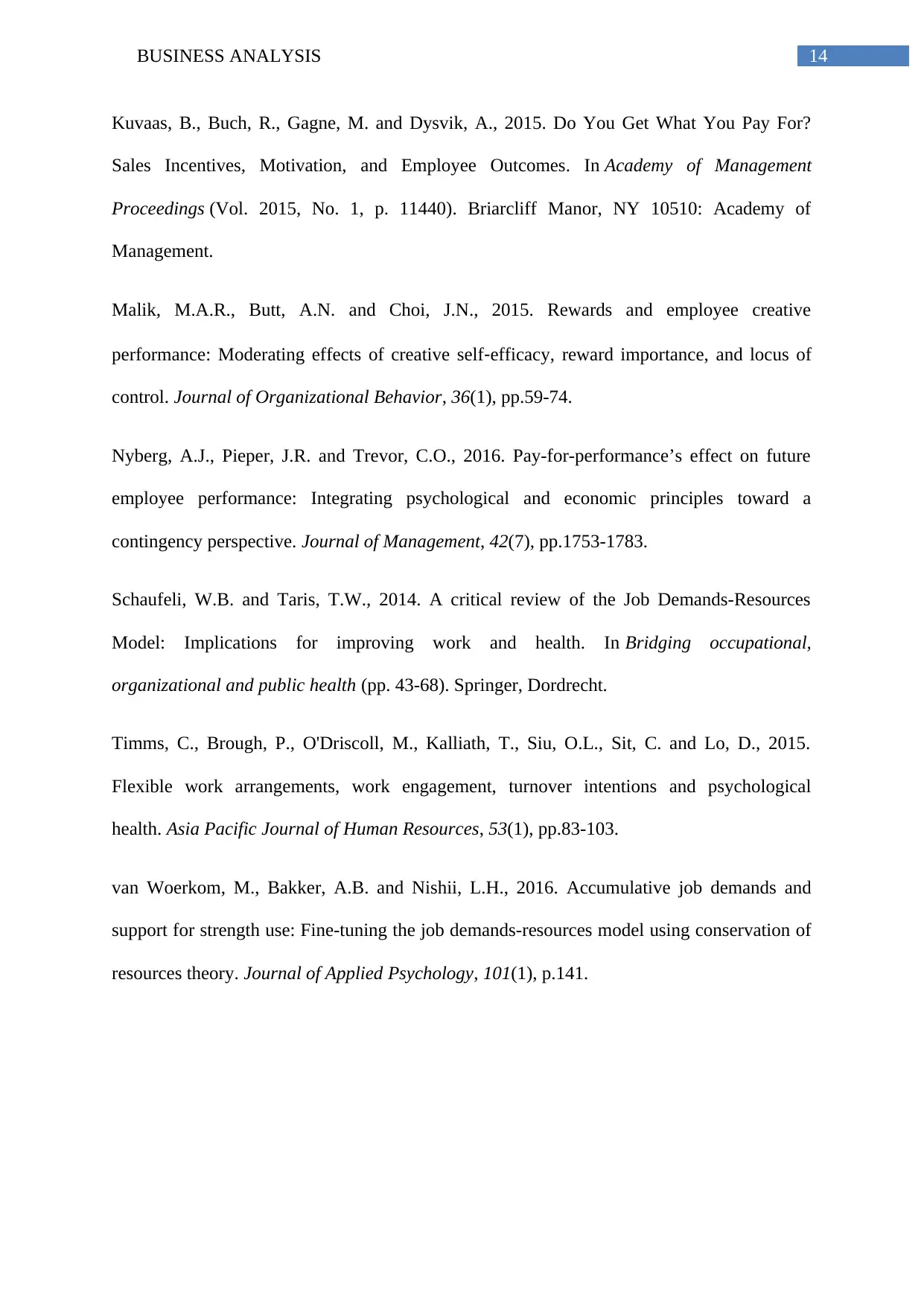
14BUSINESS ANALYSIS
Kuvaas, B., Buch, R., Gagne, M. and Dysvik, A., 2015. Do You Get What You Pay For?
Sales Incentives, Motivation, and Employee Outcomes. In Academy of Management
Proceedings (Vol. 2015, No. 1, p. 11440). Briarcliff Manor, NY 10510: Academy of
Management.
Malik, M.A.R., Butt, A.N. and Choi, J.N., 2015. Rewards and employee creative
performance: Moderating effects of creative self‐efficacy, reward importance, and locus of
control. Journal of Organizational Behavior, 36(1), pp.59-74.
Nyberg, A.J., Pieper, J.R. and Trevor, C.O., 2016. Pay-for-performance’s effect on future
employee performance: Integrating psychological and economic principles toward a
contingency perspective. Journal of Management, 42(7), pp.1753-1783.
Schaufeli, W.B. and Taris, T.W., 2014. A critical review of the Job Demands-Resources
Model: Implications for improving work and health. In Bridging occupational,
organizational and public health (pp. 43-68). Springer, Dordrecht.
Timms, C., Brough, P., O'Driscoll, M., Kalliath, T., Siu, O.L., Sit, C. and Lo, D., 2015.
Flexible work arrangements, work engagement, turnover intentions and psychological
health. Asia Pacific Journal of Human Resources, 53(1), pp.83-103.
van Woerkom, M., Bakker, A.B. and Nishii, L.H., 2016. Accumulative job demands and
support for strength use: Fine-tuning the job demands-resources model using conservation of
resources theory. Journal of Applied Psychology, 101(1), p.141.
Kuvaas, B., Buch, R., Gagne, M. and Dysvik, A., 2015. Do You Get What You Pay For?
Sales Incentives, Motivation, and Employee Outcomes. In Academy of Management
Proceedings (Vol. 2015, No. 1, p. 11440). Briarcliff Manor, NY 10510: Academy of
Management.
Malik, M.A.R., Butt, A.N. and Choi, J.N., 2015. Rewards and employee creative
performance: Moderating effects of creative self‐efficacy, reward importance, and locus of
control. Journal of Organizational Behavior, 36(1), pp.59-74.
Nyberg, A.J., Pieper, J.R. and Trevor, C.O., 2016. Pay-for-performance’s effect on future
employee performance: Integrating psychological and economic principles toward a
contingency perspective. Journal of Management, 42(7), pp.1753-1783.
Schaufeli, W.B. and Taris, T.W., 2014. A critical review of the Job Demands-Resources
Model: Implications for improving work and health. In Bridging occupational,
organizational and public health (pp. 43-68). Springer, Dordrecht.
Timms, C., Brough, P., O'Driscoll, M., Kalliath, T., Siu, O.L., Sit, C. and Lo, D., 2015.
Flexible work arrangements, work engagement, turnover intentions and psychological
health. Asia Pacific Journal of Human Resources, 53(1), pp.83-103.
van Woerkom, M., Bakker, A.B. and Nishii, L.H., 2016. Accumulative job demands and
support for strength use: Fine-tuning the job demands-resources model using conservation of
resources theory. Journal of Applied Psychology, 101(1), p.141.
1 out of 15
Related Documents
Your All-in-One AI-Powered Toolkit for Academic Success.
+13062052269
info@desklib.com
Available 24*7 on WhatsApp / Email
![[object Object]](/_next/static/media/star-bottom.7253800d.svg)
Unlock your academic potential
© 2024 | Zucol Services PVT LTD | All rights reserved.





